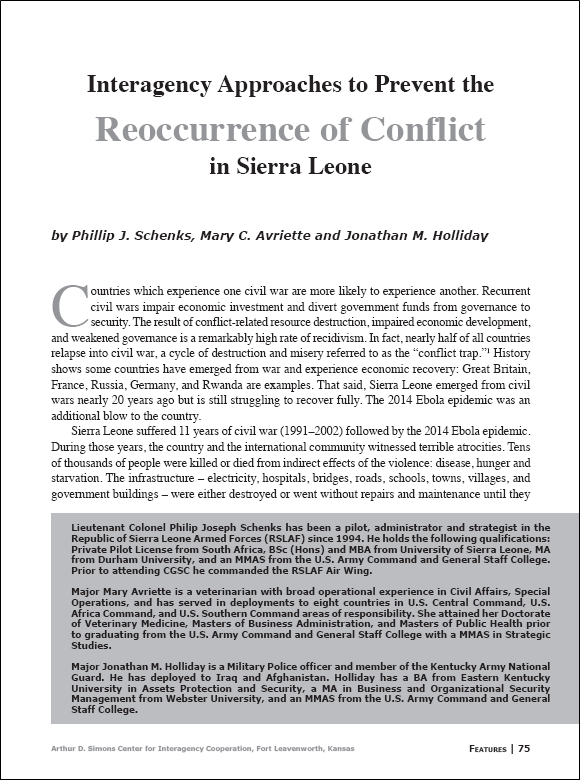Tag: Conflict Prevention
Featured article: The Influence of Transhumanist Thought on Human Enhancement by Jeff Sheets In the April 2017 edition of National Geographic Magazine, journalist D.T. Max describes his encounter with cyborg Neil Harbisson. Color blind from birth due to a condition called achromatopsia, Harbisson had a fiber-optic sensor fixed onto the back of his skull. This […]
... Read MoreFeatured article: Artificial Intelligence-Enabled Autonomous Weapon Systems and the Laws of Armed Conflict by Dustin P.J. Murphy Artificial Intelligence (AI) is changing the world and it will change the nature, speed, and scope of war. AI promises to benefit humanity but it also generates fear because of the unknowns associated with its advancement, especially the potential of […]
... Read MoreFeatured article: Lessons on Collaboration from Recent Conflicts: The Whole-of-Nation and Whole-of-Government Approaches in Action by Brett Doyle Attempts to bring peace and stability in conflict plagued areas have dominated the foreign policy of the United States. In the era of globalization, however, the U.S. is only a single player in an increasingly complex “maze” of organizations […]
... Read MoreFeatured article: Interagency Approaches to Prevent the Reoccurrence of Conflict in Sierra Leone by Phillip J. Schenks, Mary C. Avriette and Jonathan M. Holliday Countries which experience one civil war are more likely to experience another. Recurrent civil wars impair economic investment and divert government funds from governance to security. The result of conflict-related resource […]
... Read MoreFeatured article: Disenfranchisement Breeds Conflict by Benjamin E. Birtles Conflict arises from various sources of competition loosely categorized as either realistic or non-realistic. Disenfranchisement increases group stress leading to increased non-realistic conflict sources, thereby contributing to a higher probability of physical violence. Forcibly implementing political systems that cause disenfranchisement sets the stage for future conflict leading to […]
... Read MoreFeatured article: Deep Analysis: Designing Complexity Into Our Understanding of Conflict by Thomas G. Matyók, Hannah Rose Mendoza and Cathryne Schmitz Conflict is inherently messy, and today those analyzing conflicts are confronted with an incredible number of problems that resist resolution. Chaos, ambiguity, and contradiction are routine. The vast majority of today’s social conflicts can […]
... Read MoreArmy University Press recently published “Cultural Perspectives, Geopolitics & Energy Security of Eurasia: Is the Next Global Conflict Imminent?” under the auspice of Culture, Regional Expertise and Language Management Office. The anthology looks at the military and diplomatic dynamics of the Eurasia region, and provides cultural context of the region. The anthology is divided into three sections: […]
... Read MoreFeatured article: Evaluation of Current Risk Assessment Models for Genocide and Mass Atrocity by Kathryn Gillum Genocide and other atrocity crimes (war crimes and crimes against humanity) are not only a curse to those directly involved, but also a burden on all of humanity. Under the United Nations’ (UN) 2005 Responsibility to Protect (R2P), the international […]
... Read MoreLast week, the U.S. Army Peacekeeping and Stability Operations Institute (PKSOI) published Impunity: Countering Illicit Power in War and Transition. The work contains a collection of case studies and analyses on the dynamics associated with illicit power and state weaknesses relating to preventing or resolving armed conflict. Impunity addresses how to effectively respond to the illicit […]
... Read MoreChairman of the Joint Chiefs of Staff, Army General Martin E. Dempsey recently conducted an interview in which he discussed the importance of a whole-of-government approach to issues facing the U.S. and the world. Dempsey has repeatedly pushed for solutions integrating economic, diplomatic, law enforcement, energy, and military instruments of power during his tenure as […]
... Read More"*" indicates required fields









